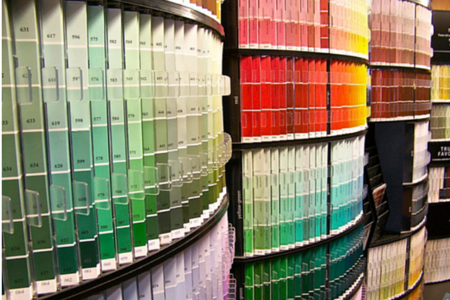How to Pick the Right Paint
Most of us choose paint based on local availability, cost, and color. But there is more to selecting paint than meets the eye. Architects choose paint based on building use, location, substrate, color, product longevity, safety, and warranty.
Our #1 tip…don’t skimp on the quality! When hiring a professional to paint you can expect labor to be 85-90% of the project cost. Cheap paint is hard to work with and in the long run will end up costing more in labor. Quality paint will last longer and cover better.
Quality paint = longer lasting results and a happy painter!
Knowing about the components that make up paint, how paint is manufactured, as well as a few helpful tips will ensure paint selection success.
Paint Components
- Pigment adds color and opacity. Pigments are “molecules that absorb specific wavelengths (energies) of light and reflect all others.” The color we see is the net effect of all the light reflecting back at us.
- Binder is a resin that holds the pigment in place. Resins provide adhesion, flexibility, and hardness. They also provide resistance to elements in our environment such as moisture, chemicals, and ultraviolet light.
- Extender improves adhesion and strength
- Solvent thins the paint to allow for easier application
- Additive modifies the properties of the paint for special uses
Paint Manufacturing
Paints are developed for specific uses, whether as a primer or as an architectural finish. The pigment is coated and dispersed by the resin, to which a solvent is added to achieve the desired consistency.
The final step is to mix in additives which are selected for special situations. Additives can be quite sophisticated, depending on the intended use. Here are a few examples:
- Kilz is a common primer that includes a base which covers and seals stains.
- Red oxide primer includes an additive that helps the finish coat to bond to metals.
- Intumescent coatings include an additive that provides a fire-resistant barrier on structural steel that requires a fire rating.
Tips on Choosing Paint
Choose paint based on the substrate and use of the space. Here are a few examples:
- For concrete block walls in an elementary school, we may specify tough washable paint in bright colors that reinforce the exuberance of youth.
- Offices are usually painted in a washable, flat or eggshell finish. We usually specify neutral colors which limit eye strain, increase efficiency, and are widely liked.
- In healthcare environments, we use washable paint and include colors that are soothing, promote healing, and inspire patient confidence.
- Washable surfaces are important in food service locations and restaurants. We specify colors that stimulate conversation and appetite.
Choose paint based on its safety, durability and longevity. Not all paints are created equal. We look for low or no VOC latex paint for most applications. We look for colors that are stable and long-lasting. Red, yellow, and orange are the least stable colors. If you have painted a wall red or have owned a red car, you have observed the weathering and fading that takes place. Why is this? Paint pigments vary and some are more stable than others.
Organic pigments in paint give us bright vibrant colors, like red, orange, and yellow, which are susceptible to fading and heat. Ultraviolet rays and oxygen can break down their chemical bonds. Organic pigments have a small particle size which causes them to be transparent.
Inorganic pigments in paint give us earth-tone colors. They have larger particle sizes which make them opaque. They also have high fade and weather-resistance
Although choosing paint for a project may seem like a simple decision, there is more to it than meets the eye. Call us for paint and coatings advice for your project: 847-247-0303.
For more information on paint and coatings, visit manufacturers’ websites. We like Benjamin Moore and Pittsburgh paints for general applications. Always follow manufacturers’ instructions for safety.



